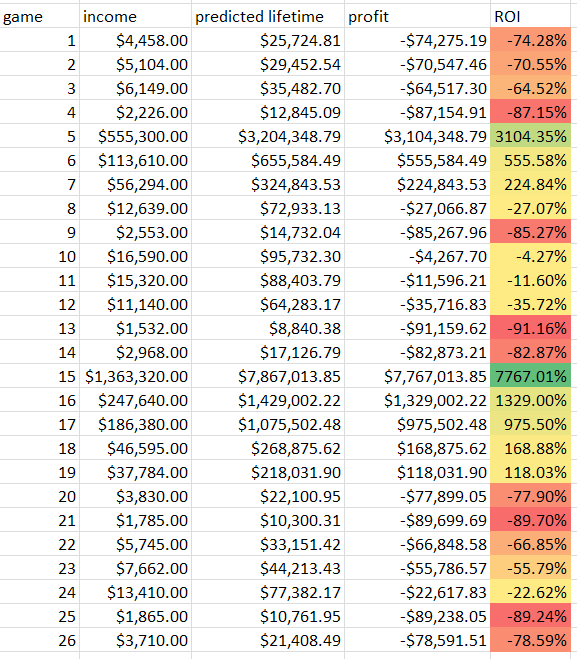In a sudden fit of spreadsheet fun, I looked at steam spy data for 26 indie games that were released roughly a month ago. I then calculated their approximate revenue. Then, I looked at a recent game positech released (Big Pharma) and worked out what percentage of the last 7 months revenue was from month1. Using that, I extrapolated the final income for the first 6 months for each of those games. I assumed each game had cost $100,000 to make. (Possibly an over-reaction, but don’t forget the time involved). Anyway, the profits, and ROI are shown below…
So lets assume I was being crushingly silly here, and instead look at a very long tail of a game, such as Democracy 3, and use the stats from its month 1 vs total income and use that to calculate ‘lifetime’ income, assuming multiple patches, DLC releases, sales and so on, given month 1 income:
 So what non-scientific stats can be drawn from this? well… even if you are prepared to wait for two and a half years to see the money come in, 69% of indie games are going to lose money. Looking at those stats, the overall income was 13 million dollars so the ‘average’ game made a half-million dollars profit. WAHEY! But obviously thats bollocks, because the median game made a 55% loss. Without any mitigating factors, you are statistically likely to make a loss.
So what non-scientific stats can be drawn from this? well… even if you are prepared to wait for two and a half years to see the money come in, 69% of indie games are going to lose money. Looking at those stats, the overall income was 13 million dollars so the ‘average’ game made a half-million dollars profit. WAHEY! But obviously thats bollocks, because the median game made a 55% loss. Without any mitigating factors, you are statistically likely to make a loss.
Here is another way to look at it. Chop off the top 3 selling ‘hits’ and the ‘average earned by the remaining games is a profit of $40k over two years. Thats actually not that bad a ROI.
Another way to look at it: there is a 34% chance that you will lose 75% of your money if you make an indie game.
Figures are fun.
edit: Forgot to take off steams percentage soo…. assume the figures are even less optimistic, or that your game costs $70k to make :D
